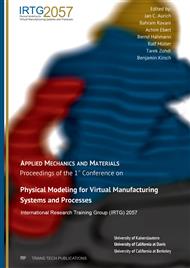[1]
Evans C., Paul E., Dornfeld D., Lucca D., Byrne G., Tricard M., Klocke F., Dambon O., Material removal mechanisms in lapping and polishing, Annals of the CIRP, 52/2 (2003) 611-633.
DOI: 10.1016/s0007-8506(07)60207-8
Google Scholar
[2]
Yu G., Walker D., Li H., Implementing a grolishing process in Zeeko IRP machines, Applied optics, 51/27 (2012) 6637-6640.
DOI: 10.1364/ao.51.006637
Google Scholar
[3]
Beaucamp A., Namba Y., Combrinck H., Charlton P., Freeman R., Shape adaptive grinding of CVD silicon carbide, Annals of the CIRP, 63/1 (2014) 317-320.
DOI: 10.1016/j.cirp.2014.03.019
Google Scholar
[4]
Walker D., Beaucamp A., Freeman R., McCavana G., Morton R., Use of the Precessions process for pre-polishing and correcting 2D & 2. 5D Form, Optics Express, 14/24 (2006) 11787-11795.
DOI: 10.1364/oe.14.011787
Google Scholar
[5]
Messelink W., Faehnle O., Exploiting the Process Stability of Fluid Jet Polishing, Optical Fabrication and Testing, OSA Technical Digest (2008) OThD3.
DOI: 10.1364/oft.2008.othd3
Google Scholar
[6]
Riveros R., Mitsuishi I., Takagi U., Ezoe Y., Mitsuda K., Yamaguchi H., Boggs T., Ishizu K., Magnetic Field-Assisted Finishing of Silicon Microelectromechanical Systems Micropore X-Ray Optics, Journal of Manufacturing Science and Engineering, 134/5 (2012).
DOI: 10.1115/1.4006967
Google Scholar
[7]
Mori Y., Yamauchi K., Endo K., Elastic emission machining, Precision Engineering 9/3 (1987) 123-128.
DOI: 10.1016/0141-6359(87)90029-8
Google Scholar
[8]
Suzuki H., Moriwaki T., Okino T., 2006, Development of ultrasonic vibration assisted polishing machine for micro aspheric die and mold, Annals of the CIRP, 55/1: 385-388.
DOI: 10.1016/s0007-8506(07)60441-7
Google Scholar
[9]
Mori Y., Yamauchi K., Yamamura K., Sano Y., Development of plasma chemical vaporization machining, Rev. of Scientific Instruments, 71/12 (2000) 4627-4632.
DOI: 10.1063/1.1322581
Google Scholar
[10]
Drueding T., Fawcett S., Wilson S., Bifano T., Ion beam figuring of small optical components, Optical engineering, 34/12 (1995) 3565-3571.
DOI: 10.1117/12.215648
Google Scholar
[11]
Klocke F. and König W., Manufacturing Processes 2 (2009).
Google Scholar
[12]
Malkin S. and Ritter J., Grinding mechanisms and strength degradation for ceramics. Journal of Engineering for Industry 111/2 (1989) 167-174.
DOI: 10.1115/1.3188746
Google Scholar
[13]
D. Magda, Understanding the Effect of Residual Stresses on Surface Integrity and how to Measure them by a Non-Destructive Method. ASEE (2008) 13. 1313. 1-17.
DOI: 10.18260/1-2--3560
Google Scholar
[14]
T. Bifano, T. Dow, R. Scattergood, Ductile-regime grinding: a new technology for machining brittle materials. Transactions of ASME 113 (1991) 184-189.
DOI: 10.1115/1.2899676
Google Scholar
[15]
H. Kim, J. Kim, Y. Kwon, Mechanical properties of binderless tungsten carbide by spark plasma sintering. Proc. 9th Russian-Korean International Symposium on Science and Technology (2005) 458-461.
DOI: 10.1109/korus.2005.1507757
Google Scholar
[16]
A. Beaucamp, Y. Namba, H. Combrinck, P. Charlton, R. Freeman, Shape adaptive grinding of CVD silicon carbide. Annals of the CIRP 63/1 (2014) 317-320.
DOI: 10.1016/j.cirp.2014.03.019
Google Scholar
[17]
A. Beaucamp, Y. Namba, P. Charlton, Process mechanism in shape adaptive grinding (SAG). Annals of the CIRP 64/1 (2015) 305-308.
DOI: 10.1016/j.cirp.2015.04.096
Google Scholar
[18]
A. Beaucamp, P. Simon, P. Charlton, C. King, A. Matsubara, K. Wegener, Brittle-ductile transition in shape adaptive grinding (SAG) of SiC aspheric optics. International Journal of Machine Tools and Manufacture (2016).
DOI: 10.1016/j.ijmachtools.2016.11.006
Google Scholar
[19]
A. Beaucamp, Y. Namba, R. Freeman, Dynamic Multiphase Modeling and Optimization of Fluid Jet Polishing Process. Annals of the CIRP 61/1 (2012) 315-318.
DOI: 10.1016/j.cirp.2012.03.073
Google Scholar
[20]
A. Beaucamp, Y. Namba, W. Messelink, D. Walker, P. Charlton, R. Freeman, Surface integrity of fluid jet polished tungsten carbide. Procedia CIRP 13 (2014) 377-381.
DOI: 10.1016/j.procir.2014.04.064
Google Scholar


